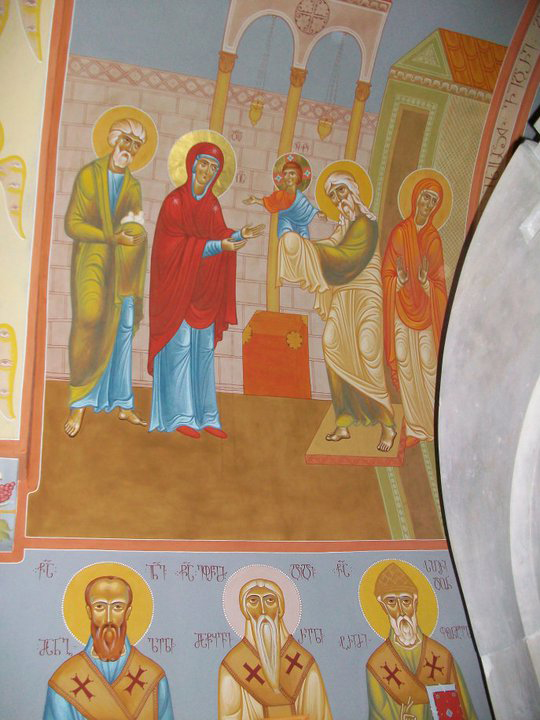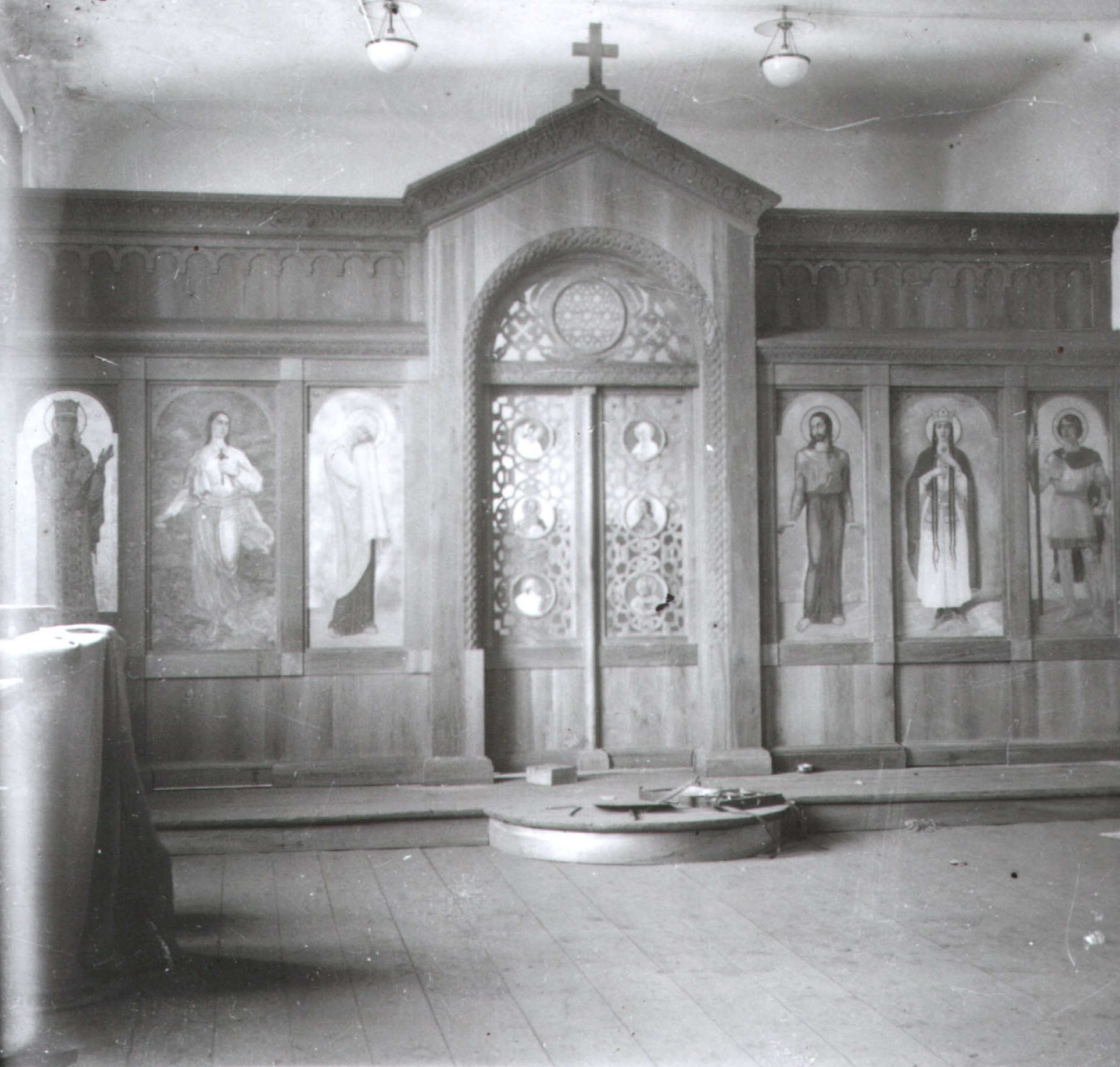Articles





Church Painting in Georgia - A. Mgaloblishvili
Twentieth-century Church Painting in Georgia
by Anna Mgaloblishvili
In the history of Georgia and especially in the history of the Georgian Church the 20th century was not monosemantic. The first two decades of national revival were followed by a 70-year period of communism with its typical atheistic mood and enmity towards the church.
The Georgian art criticism school founded by G. Chubinashvili could produce, despite prohibition and pressure, rather significant works of research about medieval and 19th-century church painting. However, research about the 20th-century soviet and pre-soviet periods, about citizens who were not acknowledged by the communistic government, and especially about issues related to the Christian religion was made impossible. The inaccessibility of the historic materials resulted in the wrong assumption that this period was characterized by a lack of significant church painting.
The post-soviet era provided new challenges for the Georgian society and Church. Interest in icons and monumental church painting has increased. Questions have surfaced about the essence as well as the role and further development of church painting in Georgia. In this context the study of the characteristics of Georgian church painting of the 20th century has gained new actuality.
The 20th century can be divided in the following three historical subperiods:
1. 1900-1921: the period from the beginning of the 20th century till the downfall of the first Georgian democratic republic
The 19th century in Georgia was passed under the Russian empire. In the beginning of the 20th century two important events took place in Georgian history: the restoration of the autocephaly of the Georgian Orthodox church and the declaration of Georgian’s independency in 1918. Public involvement of the Georgian clergy in due course led to the engagement of Georgian artists in church painting. The church paintings of this period were created by the following artists: Gigo Zaziashvili (Church of St. Nicholas in Tbilisi and Church of Aspiration of Virgin in Shiomgvime); Nicholas Andreev (Church of Aspiration of Virgin in Shiomgvime); Mikhail Nesterov (Church of St. Alexander Nevski in Abastumani); Henryk Hrynevski (Kashveti Church Chancel-barrier in Tbilisi); Dimitri Shevardnadze (Chancel-barrier of the Chiatura Mining-Technical College); Valerian Sidamon-Eristavi (Two triptychs in the Church of the Virgin in Telavi).
 Dimitri Shevardnadze, Chancel-barrier of the Chiatura Mining-Technical College
Dimitri Shevardnadze, Chancel-barrier of the Chiatura Mining-Technical College

Mikhail Nesterov: Crucifixion, Church of St. Alexander Nevski in Abastumani
From a technical point of view church painting of the beginning of the 20th century remained true to oil painting. The painted programs basically followed Byzantine tradition. The stylistic features of the church paintings reveal tendencies that prevailed in European art in general. Another very important feature of church painting of this period is a desire to emphasize events and issues related to national tradition and to assimilate characteristics of Georgian traditional art.
2. 1921-1990: the communistic period
Communism battled against religious beliefs and activities. In this period on the one hand artifacts of a religious nature were created and functioned in an 'underground' atmosphere, whereas on the other hand in a few instances the authorities proved loyal to artists who made religious murals in churches.
After World War II three churches were painted (be it only partly): Kashveti (St. George’s) Church was painted by Lado Gudiashvili (1946-1948); Didube (Mother of God’s) Church was painted by Alexander Bandzeladze (1978-1988); Tbilisi Sioni Cathedral was painted by Levan Tsutskiridze (during the 80’s).

Lado Gudiashvili, Kashveti Church in Tbilisi

Levan Tsutskiridze, Sioni Cathedral Tbilisi
These churches were painted by outstanding and successful modern artists of that period following direct orders of the Patriarchs of the Georgian Church. The monumental art found in the incomplete wall-paintings of the three churches is indicative of the fact that in order to find new solutions to theological and artistic problems Georgian artists applied traditional as well as new methods and in fact strove to restore and re-establish the traditions of Georgian religious art. It must be mentioned that all three churches were painted in fresco technique.
3. 1990 – the present: the post-communistic period
After the collapse of the soviet empire, in the post-communist era, new democratic processes were started. After the years of oppression the role and place of religion in society was perceived in a new way. A great number of new monasteries were built and painted and new icons created. Issues of the identity of Christian art, ways of portrayal, and directions for future development were discussed. Church art returned to the patterns of Byzantine Art with its characteristic materials (egg tempera on wooden panel for icons; applying painting to the moist plaster for wall-paintings) and style (two-dimensional treatment, no perspective, colors without tonal gradations, placing one color upon the other, the absence of a single light source).

Lasha Kincurashvili, Sioni Cathedral Tbilisi

Father Lazare, Bethania Church
*******
Anna Mgaloblishvili is a Georgian painter and art historian. She studied painting at the I. Nikoladze Art College and the Tbilisi State Academy of Fine Arts, where she was part of a group of students who established an experimental studio of Church Murals and Icons. It was one of the first attempts to bring church art into the university after the fall of the soviet rule in Georgia.She hasregularly participated in exhibitions in Georgia and abroad and was curator of several art projects. She has taught painting at the I. Nikoladze Art College, worked as an illustrator with various magazines and as scientific researcher at the G. Chubinashvili Institute of Georgian Art History. In 2004 she received her Ph.D. in art history. Her thesis was about the development of church painting in Georgia at the beginning of the 20th century (1900-1921). Her study made a comparative analysis of Georgian church painting with the traditions of other Orthodox countries (Greece, Russia). Since 2006 she is an assistant professor of the department of art history and theory at the Tbilisi State Academy of Arts and since 2008 she is one of the supervisor of the research direction Religious Art in the Modern World.
This article is part of the manuscript in progress: Anna Mgaloblishvili: Church Painting at the Beginning of the XX Century Georgia (1900-1921).


